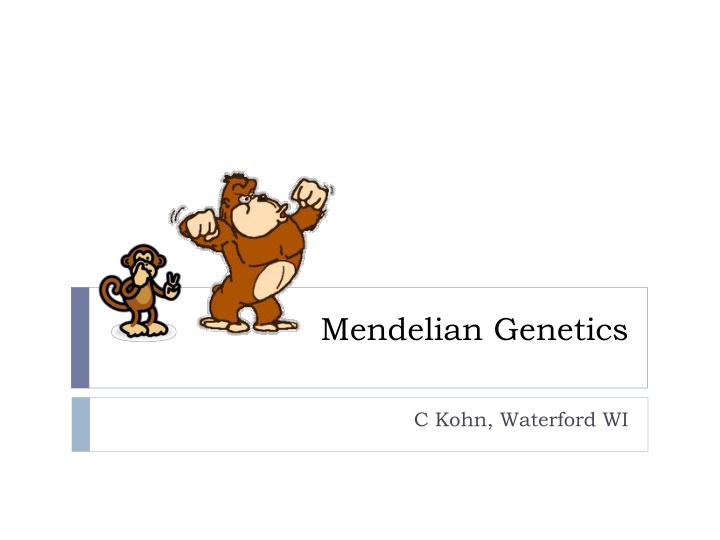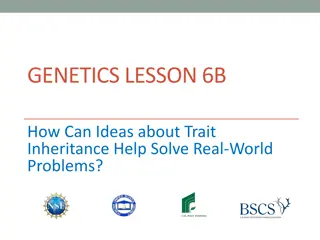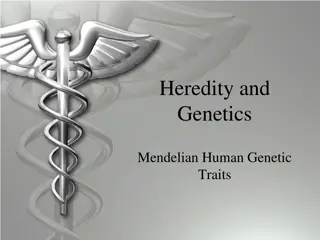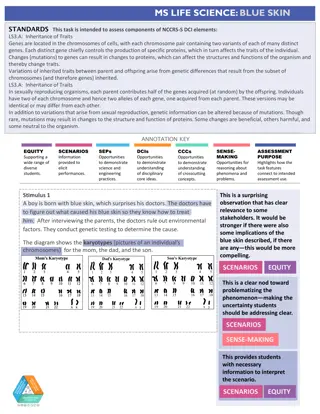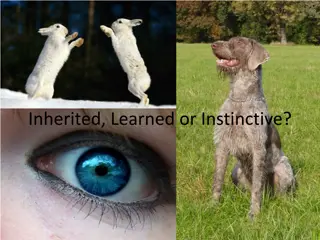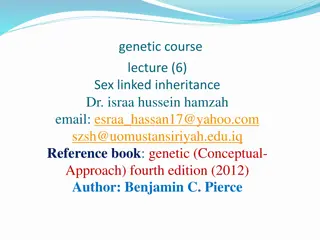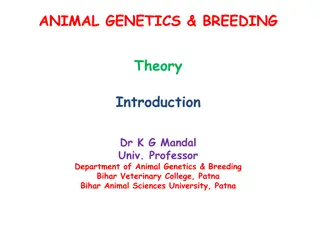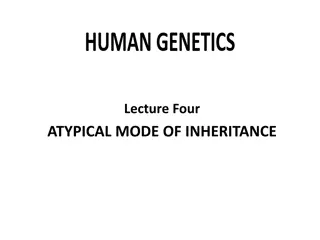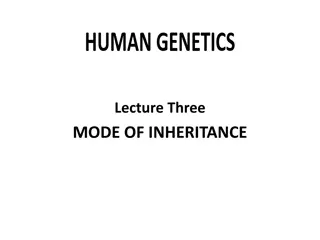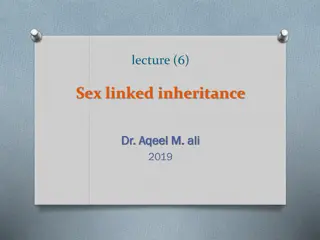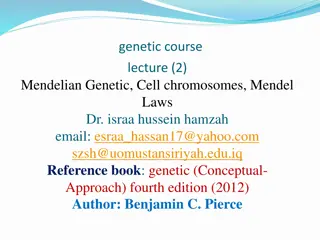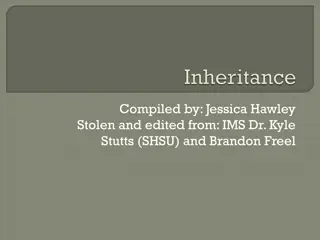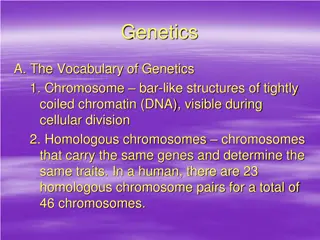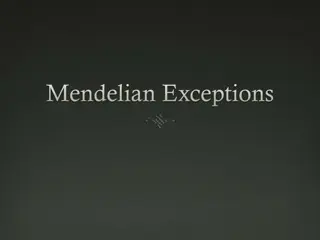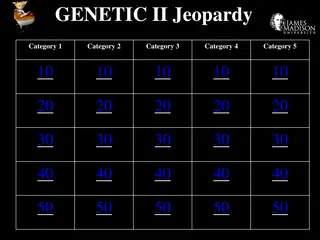Mendelian Genetics: Traits Inheritance
Genetics explores how traits are inherited through genes. Each offspring inherits copies of genes from both parents, leading to homozygous or heterozygous combinations. Genotype determines the genes an organism carries, while phenotype manifests as physical characteristics. Punnett Squares help predict genetic outcomes of offspring. Learn the 5 steps to solve Punnett Square problems and create genetic models for families. Delve into the world of genetics to understand the complexities of trait inheritance.
Download Presentation

Please find below an Image/Link to download the presentation.
The content on the website is provided AS IS for your information and personal use only. It may not be sold, licensed, or shared on other websites without obtaining consent from the author.If you encounter any issues during the download, it is possible that the publisher has removed the file from their server.
You are allowed to download the files provided on this website for personal or commercial use, subject to the condition that they are used lawfully. All files are the property of their respective owners.
The content on the website is provided AS IS for your information and personal use only. It may not be sold, licensed, or shared on other websites without obtaining consent from the author.
E N D
Presentation Transcript
Mendelian Genetics C Kohn, Waterford WI
Genetics Genetics is the study of inheritance of genes. i.e. genetics is how traits are passed down from parents to offspring Every individual offspring inherits at least two copies of every gene one from the mother and one from the father. Each version of a gene is called an allele. You inherit at one allele from both parents for every gene. Genes can either be dominant or recessive Dominant genes are always expressed if they are present Recessive genes are only expressed if no dominant genes are present. Source: techcynic.wordpress.com Source: blogography.com
Homozygous vs. Heterozygous The combination of genes that you have can be described by homozygous or heterozygous. Homozygous means that both of your genes are the same either both are dominant or both are recessive AA would be Homozygous Dominant (both alleles are dominant) aa would be Homozygous Recessive (both alleles are recessive) Heterozygous means that you have both a dominant and a recessive copy of a gene. Aa would be Heterozygous (one dominant allele, one recessive allele) Source: zazzle.com
Genotype vs. Phenotype Genotype is the term for the genes that an organism has. Phenotype are the physical characteristics created by the combination of genes that an organism has. For example, Mr. Kohn is heterozygous for eye color his genotype has genes for both blue and brown eyes. However, Mr. Kohn s phenotype is brown eyes the blue eye color is not expressed because it is recessive. A A a Aa Aa Aa Aa a
Punnett Squares A Punnett Square is a tool used for determining the possible genetic outcomes of the offspring of two parents Punnett Squares are can be used to determine the parents or offsprings phenotypes and genotypes. Punnett Squares show all of the possible combinations of offspring genotypes that a couple could have. A A a Aa Aa Aa Aa a
How would you create a Punnett Square for this family?
5 Steps of Punnett Square Problems Step 1: Figure out what is recessive. Usually the trait that is dominant is more common. Usually the trait that is recessive is less-prevalent. In this case, we can tell that purple is recessive and green is dominant.
5 Steps of Punnett Square Problems Step 2: Determine the genotypes of the parents One is pretty simple the purple recessive parent has to have two little letters: aa The other green parent has only two possibilities AA or Aa So we know that one parent is aa and the other is either Aa or AA.
5 Steps of Punnett Square Problems Step 3: Create the Punnett Squares for each possibility. Step 4: Select the Punnett Square that reflects what we see for offspring below. A a A A a Aa aa a Aa Aa Aa aa Aa Aa a a
5 Steps of Punnett Square Problems Step 5: Confirm that you are correct. You know that the Punnett Square on the left cannot be correct because the offspring are recessive. A a A A a Aa aa a Aa Aa Aa aa Aa Aa a a
How would you create a Punnett Square for this family?
Step 1: Figure out what is recessive Usually the recessive trait is the less-prevalent trait (not always, but usually). In this case we know both green and purple are equally common, but we know from before that green was dominant.
Step 2: Determine the genotypes of the parents We know that the purple parent has to be aa We know the green parent could either be AA or Aa
Step 3 & 4: Create Punnett Squares for each possibility; pick the correct square Create Punnett Squares for all parent genotype combo possibilities You know that the Punnett Square on the left is correct because half are the dominant phenotype and half are the recessive phenotype. A a A A a Aa aa a Aa Aa Aa aa Aa Aa a a
Step 5: Confirm that you are correct. Be prepared to explain why the other Punnett Square would not work. You know that the Punnett Square on the left is correct because half are the dominant phenotype and half are the recessive phenotype. The other has only green offspring A a A A a Aa aa a Aa Aa Aa aa Aa Aa a a
Personal Test: How would you create a Punnett Square for this family?
Possible Combinations With simple traits, there are only six possible combinations of parents AA x AA AA x Aa Aa x Aa AA x aa Aa x aa aa x aa Each one will have the same results for offspring ratios each time.
Offspring Ratios If we have only recessive phenotypes, we know that both parents are homozygous recessive aa x aa If we have half recessive, half dominant phenotypes, we know that one parent is Heterozygous and one parent is Homozygous Recessive Aa and aa
Offspring Ratios If we have recessive and dominant phenotypes, we know that both parents are Heterozygous Aa and Aa If all offspring are the dominant phenotype, we know that the combination of parents must be one of the following: AA x AA Aa x AA Additional combinations would be necessary to determine which it is (except in the last example, where one parent has the recessive phenotype). AA x aa
Quiz Objectives Define an allele, a phenotype, and a genotype. Describe how homozygous recessive is different from homozygous dominant. Define heterozygous. State the genotype of an organism that has the recessive phenotype. State the genotypes of parents if they have all recessive-phenotype children. State the genotypes of parents if of their offspring have the recessive-phenotype. If half the children of a couple have recessive phenotypes, what are the genotypes of the parents? If a heterozygous couple has 3 offspring, all with the dominant phenotype, what are the odds their 4th offspring will have the recessive phenotype?
